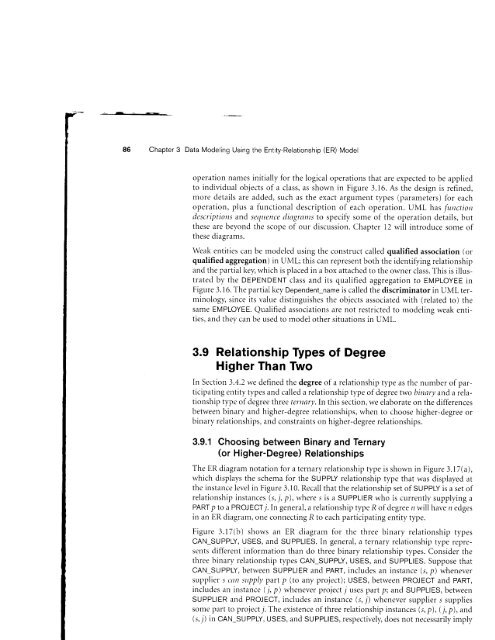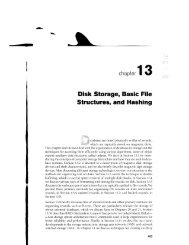this pdf excerpt
this pdf excerpt
this pdf excerpt
You also want an ePaper? Increase the reach of your titles
YUMPU automatically turns print PDFs into web optimized ePapers that Google loves.
86 Chapter 3 Data Modeling Using the Entity-Relationship (ER) Model<br />
operation narr-res initially for the logical operations that are expected to be applied<br />
to individual objects of a class, as shown in Figure 3.16. As the design is refined,<br />
n.rore details are added, such as the exact argulnent types (parameters) for each<br />
operation, plus a functional description of each operation. UML has functiort<br />
tlescriptiorrs and seqtrence diagrams to specify some of the operation details, but<br />
these are beyond the scope of our discussion. Chapter 12 will introduce some of<br />
these diagrams.<br />
Weak er-rtities can be modeled using the construct called qualified association (or<br />
qualified aggregation) in UML; <strong>this</strong> can represent both the identifring relationship<br />
and the partial ke,v, which is placed in a box attached to the owner class. This is illustrated<br />
by the DEPENDENT class and its qualified aggregation to EMpLOyEE in<br />
Figure 3.16. The partial key Dependent_name is called the discriminator in UML termir-rology,<br />
since its value distinguishes the objects associated with (related to) the<br />
same EMPLOYEE. Qualified associations are not restricted to modelins weak entities,<br />
and they can be used to n-rodel other situations in UML.<br />
3.9 Relationship Types of Degree<br />
Higher Than Two<br />
In Section 3.4.2 we defined the degree of a relationship type as the number of participating<br />
entity types and called a relatior-rship type of degre e Iwo binary and a relationship<br />
type of degree three ternary.ln <strong>this</strong> section, we elaborate on the differences<br />
between binary and higher-degree relationships, when to choose higher-degree or<br />
binary relationships, and constraints on higher-degree relationships.<br />
3.9.1 Choosing between Binary and Ternary<br />
(or Higher-Degree)<br />
Relationships<br />
The ER diagram notation fbr a ternary relationship type is shown in Figure 3.17(a),<br />
which displays the schema for the SUPPLY relationship type that was displayed irt<br />
the instance level in Figure 3.10. Recall that the relationship set of SUPPLY is a set of<br />
relationshipr instances (s, j, p), r,vhere s is a SUPPLIER who is currently supplying a<br />
PARTp to a PROJECT.i. In general, a relationship type R of degree n will have ir edges<br />
in an ER diagram, one connecting R to each participating entity type.<br />
Figure 3.17(b) shows an ER diagrarn for the three binary relatior-rship types<br />
CAN_SUPPLY, USES, and SUPPLIES. ln general, a ternary reiationship type represer.rts<br />
different infbrrnation than do three binary relationship types. Consider the<br />
tl-rree binary relationship types CAN_SUPPLY, USES, and SUPPLIES. Suppose that<br />
CAN SUPPLY, betrveen SUPPLIER and PART, includes an instance (s,p) whenever<br />
supplier s cotr strpply partp (to any project); USES, between PROJECT and PART,<br />
ir-rcludes an instance (.1,p) whenever project/ uses partp; and SUPPLIES, between<br />
SUPPLIER rrnd PROJECT, includes an instance (s, j) whenever supplier s supplies<br />
some part to project j. The existence of three relationship instances (s,p),( j,p), and<br />
(s,7) in CAN_SUPPLY, USES, and SUPPLIES, respectively, does not necessarily imply














